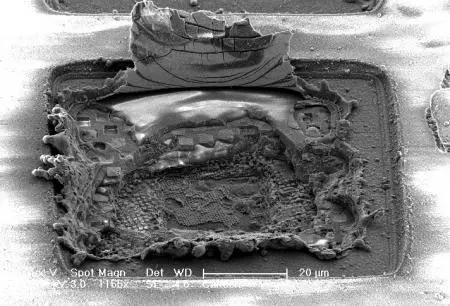Although you are fairly unlikely to start zapping your gadgets with high-power lasers any time soon, scientists are already hard at work trying to make electronics immune to such cruelty. In another in a series of self-healing electronics breakthroughs, a team of scientists from the California Institute of Technology (Caltech) demonstrated chips capable of dealing not only with laser-inflicted physical damage but also with far more common ailments such as aging, power fluctuations, changes in temperature or load mismatch.
Some time ago we described carbon nanotube-filled microcapsules that, when ruptured, restore the electrical conductivity to parts of the system affected by physical damage. Caltech’s idea is different. Instead of trying to restore original properties to a damaged area, the goal here is to find the best possible workaround in as short a time as possible.
While this strategy is not new, it is the flexibility and efficiency of the solution that deserves the most attention. The chips are fitted with sensors monitoring temperature, power, current and voltage. This data is then interpreted by a central processor (a custom-designed ASIC or an application-specific integrated-circuit) which evaluates the general performance of the system and works out the optimum states for all the available actuators (the changeable parts of the chip).
"You tell the chip the results you want and let it figure out how to produce those results," says Steven Bowers, lead author of a paper on the technology.

This means the chip does not have to be programmed for all the possible failure scenarios. Instead it is able to respond to any number of failures flexibly and improve the overall system performance in the process, even though the whole circuitry responsible for the self-healing effect requires additional energy. In fact, the self-healing power amplifiers would gobble up roughly half the amount of energy devoured by their equivalents without a self-healing system. Their performance would also be more predictable and easier to reproduce.
The power amplifiers for millimeter-wave frequencies used to demonstrate this system are on the cutting edge of integrated circuit technology. Since the solution has been demonstrated to work in such sophisticated systems, it is safe to say it can be extended to practically all other kinds of electronic systems.
"Bringing this type of electronic immune system to integrated-circuit chips opens up a world of possibilities," says Ali Hajimiri, the Thomas G. Myers Professor of Electrical Engineering at Caltech. "It is truly a shift in the way we view circuits and their ability to operate independently. They can now both diagnose and fix their own problems without any human intervention, moving one step closer to indestructible circuits."
As seems to be the case with nearly all research projects involving cool things like high power lasers, the work was funded by the Defense Advanced Research Projects Agency (DARPA) and the Air Force Research Laboratory. The paper on the research is featured in the March issue of the scientific journal IEEE Transactions on Microwave Theory and Techniques.
Source: Caltech




